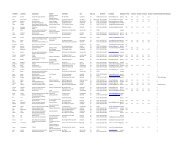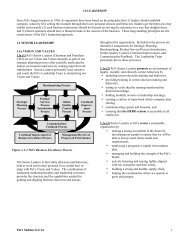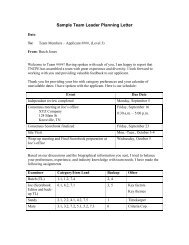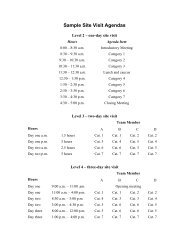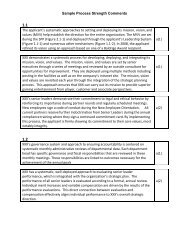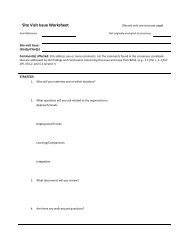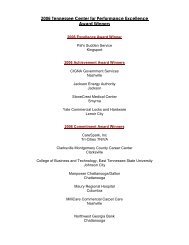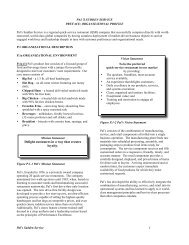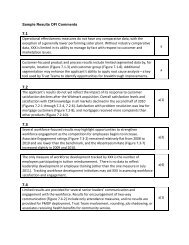Preface: Organization Profile - Tennessee Center for Performance ...
Preface: Organization Profile - Tennessee Center for Performance ...
Preface: Organization Profile - Tennessee Center for Performance ...
You also want an ePaper? Increase the reach of your titles
YUMPU automatically turns print PDFs into web optimized ePapers that Google loves.
<strong>Organization</strong>al <strong>Profile</strong><br />
Segment<br />
TMs<br />
Physicians<br />
Volunteers<br />
Students<br />
community’s needs.<br />
Key WF Engagement Factors<br />
Engagement Factors<br />
Recognition, cooperation in the work unit, respect<br />
Ability to provide quality patient care, access to<br />
state-of-the-art equipment, appropriate facilities<br />
Recognition<br />
Access to applicable experiences<br />
Figure P.1-3 Key WF Engagement Factors<br />
Boards: The 13-member System Board of Directors provides<br />
overall governance and strategic oversight. Except <strong>for</strong> the<br />
President/Chief Executive Officer (CEO), who sits on the<br />
System Board, all board members are independent<br />
volunteers. Community Boards set long range plans <strong>for</strong> the<br />
hospitals within their counties, and work closely with leaders<br />
in each hospital, who have day-to-day management<br />
responsibility. Additional subsidiary boards, such as<br />
BRMMC, MS Foundation, and MSHA Auxiliary, oversee<br />
aspects of the corporation that require separate governance<br />
structures. The System Board approves all decisions of the<br />
Community Boards and subsidiary boards.<br />
MECs: MECs are responsible <strong>for</strong> the credentialing of<br />
physicians, nurse practitioners, and physician assistants <strong>for</strong><br />
practice privileges. These are county-based committees<br />
Type of<br />
Position<br />
Status<br />
Gender<br />
MSHA TM Demographics<br />
Factor <strong>Profile</strong> # / % of total staff – 7,813<br />
Race / Ethnicity<br />
Tenure<br />
Median Age<br />
Clinical 5202 / 66.6%<br />
Non-clinical 1973 / 25.3%<br />
Management 638 / 8.1%<br />
Full Time 5897 / 75.5%<br />
Part-time 1916 / 24.5%<br />
Male 1558 / 19.9%<br />
Female 6255 / 80.1%<br />
White 7552 / 96.7%<br />
African-American 112 / 1.4%<br />
Hispanic 43 / 0.6%<br />
Other 106 / 1.3%<br />
Clinical<br />
<strong>Profile</strong><br />
Non-clinical<br />
Management<br />
Clinical<br />
Non-clinical<br />
Management<br />
Figure P.1-4 MSHA TM Demographics<br />
# Years<br />
6 yrs.<br />
7.53 yrs.<br />
11.52 yrs.<br />
39.2 yrs.<br />
44.4 yrs.<br />
46.9 yrs.<br />
Body<br />
U.S. Office of Civil Rights<br />
(HIPPA)<br />
IRS<br />
State of TN/<br />
Commonwealth of VA<br />
<strong>Center</strong>s <strong>for</strong> Medicare and<br />
Medicaid Services (CMS)<br />
Office of Inspector General<br />
EPA<br />
OSHA/TOSHA<br />
EEOC<br />
Nuclear Regulatory<br />
Commission<br />
FDA<br />
Joint Commission<br />
CAP<br />
CARF<br />
CAVL<br />
ACSC on Cancer<br />
CHAPS<br />
AASM<br />
AACPR<br />
ACR<br />
American Osteopathic<br />
Association (AOA)<br />
Legal and Regulatory Environment<br />
Area<br />
Privacy and security of data<br />
Not-<strong>for</strong>-profit status<br />
Licensure/certification<br />
Conditions of<br />
participation/reimbursement rules<br />
Physician compensation (Stark antikickback)<br />
Environmental protection<br />
Team member safety<br />
Equal opportunity employment<br />
Use of radioactive isotopes<br />
Pharmacy/mammography<br />
Accreditation/Certification<br />
All hospitals<br />
Long term care, Lab, Home Health<br />
(SCCH)<br />
Primary Stroke (JCMC)<br />
Clinical laboratories<br />
Rehabilitation (Quillen, NCH)<br />
Vascular laboratories<br />
Oncology<br />
Home Health (except SCCH)<br />
Sleep laboratories<br />
Cardiac rehabilitation<br />
Radiology/mammography<br />
Healthcare Facilities Accreditation<br />
Program (HFAP) (NCH, DCH)<br />
Figure P.1-5 Legal and Regulatory Environment<br />
made up of physicians elected by members of the medical<br />
staff and are led by an elected chair. This process was<br />
established within the governance structure. Provider review<br />
and recommendation take place through the MEC to each<br />
county board. Final approval of privileges occurs at the<br />
System Board.<br />
Executive Team: Executive leaders responsible <strong>for</strong> hospitals,<br />
SSUs, and system support services, join Chief Medical<br />
Officers and the CEO to <strong>for</strong>m this component of MSHA’s<br />
governance structure. This group is responsible <strong>for</strong> both<br />
strategic and operational plans and results.<br />
P.1b2 Key Market Segments, Patient and Stakeholder<br />
Groups MSHA identified its five SSUs as its key healthcare<br />
market segments. Its key stakeholders in these segments are<br />
patients and their families (referred to collectively as<br />
Mountain States Health Alliance<br />
iii




